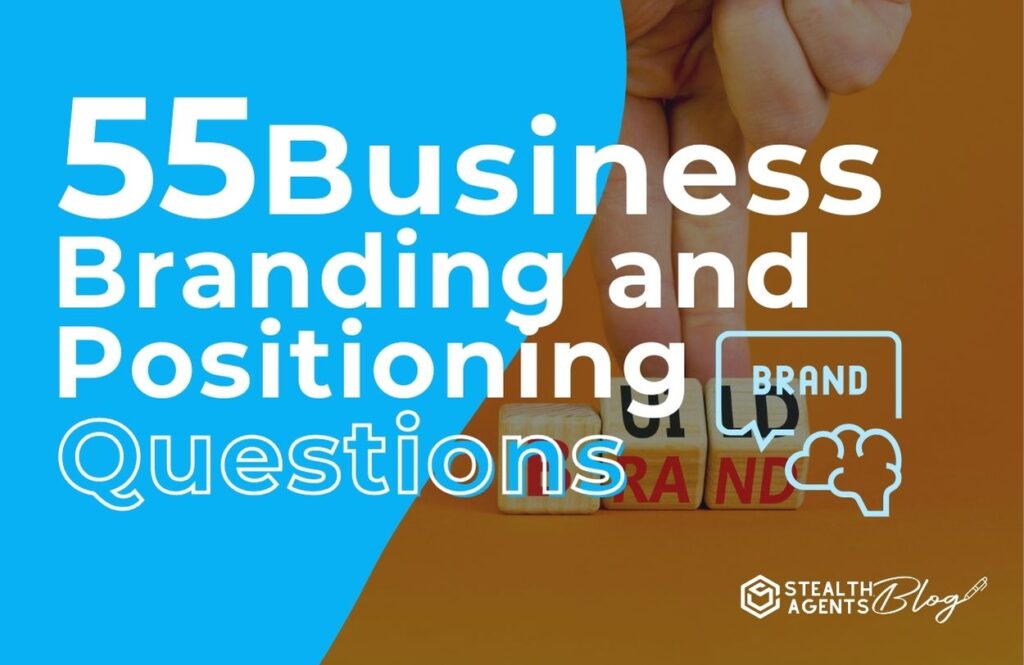Ready to take your business to the next level? Branding and positioning are more than just catchphrases—they’re the heartbeat of your business. Innovative startups and corporate giants understand the power of a strong brand in today’s competitive market.
From color psychology to tagline magic, discover 55 questions to help you navigate the complex business branding and positioning world. By the end of this session, you’ll be well-equipped to craft a brand that’s not just seen, but is heard, loved, and shared.
The Importance of Business Branding and Positioning
Branding is not just about recognition; it’s about trust. People buy from companies they trust. And how is trust earned? Through authentic, consistent, and relevant communication that holds true to your business’s core values. Your brand position, on the other hand, is about defining where you stand in relation to your competitors, highlighting the unique value you offer, and serving as a beacon for those who identify with your message.
Clear branding and positioning set the stage for success. They attract your ideal customer, foster loyalty, and ensure a consistent customer experience, leading to recognition and advocacy. So, let’s delve into the essential questions you need to consider when building or refining your brand’s presence.
List of 55 Business Branding and Positioning Questions
Here goes our comprehensive list of brand-boosting queries to strengthen your company’s presence and market positioning. You can use this list during strategy meetings, brand audits, or whenever you need a creative nudge.
-
What is the story behind our brand?
-
What is our brand’s mission and vision, and does it resonate with our target audience?
-
Who are our competitors, and how can we differentiate ourselves?
-
What are the most common misconceptions about our brand, and how can we address them?
-
What are our company values, and how do they translate into our brand messaging?
-
Is our brand promise clear, and do we consistently deliver it at every touchpoint?
-
How do our employees or team members represent our brand?
-
What was the inspiration for our brand’s name and logo?
-
Do our logo and visual elements accurately reflect our brand identity?
-
Have we defined our target audience clearly, including their demographics, behaviors, and preferences?
-
How does our brand personality resonate with our audience?
-
Are we using the right tone of voice in our communication?
-
How is our brand perceived in the market, and is that perception aligned with our goals?
-
Do we need to rebrand, and if so, what factors will we base this on?
-
How can we make our branding more inclusive and diverse?
-
Have we conducted thorough market research to understand our customer base better?
-
What branding strategies have proven successful, and how can we build on them?
-
What strategies from other industries could we adapt to improve our branding?
-
Are we telling a consistent narrative across all marketing channels?
-
How can we use customer feedback to refine our branding strategy?
-
What can we learn from our customer reviews and testimonials?
-
Is our branding adaptable to different cultural nuances and global markets?
-
Are we staying ahead of branding trends, or are we acting reactively to changes in the market?
-
Can we integrate storytelling more effectively into our branding efforts?
-
What are the psychological effects of our brand’s colors and how can we leverage this in our branding?
-
Do our branding and advertising communicate a clear benefit to our customers?
-
What single word do we want our customers to associate with our brand?
-
How can we simplify our brand messages to make them more digestible?
-
Are we taking advantage of consumer habits and behavior patterns in our branding strategies?
-
Can we create a brand ritual that gets customers to engage with our brand in a meaningful way?
-
Do we have a brand book that provides guidelines for our brand’s visual and written communication?
-
Are we providing a cohesive brand experience across all customer touchpoints?
-
How does our packaging and brand collateral enhance our overall brand image?
-
What are the most effective channels for our brand communication, and how can we optimize our presence there?
-
Are we aligning our branding with seasonal or cultural events appropriately?
-
Can we create a memorable and catchy tagline or slogan that encapsulates our brand essence?
-
How does our brand presence stack up against our strongest competitor, and what can we learn from them?
-
Can we form strategic partnerships that enhance our brand identity or reach a new audience?
-
Are we leveraging digital media to the fullest extent in our branding efforts?
-
Can we develop a content marketing strategy that builds trust and engagement with our audience?
-
How do we measure the effectiveness of our branding initiatives?
-
Are we keeping track of our brand equity and how it changes over time?
-
Are our online and offline branding initiatives synchronized for maximum impact?
-
How can we use social media to amplify our brand voice and reach?
-
Are we utilizing user-generated content to strengthen our brand’s identity?
-
Can we take an unconventional approach to branding to stand out in the market?
-
What are the legal and ethical considerations when it comes to branding, and are we adhering to them?
-
Can we secure trademarks and intellectual property to protect our brand more effectively?
-
How can we turn moments of brand crisis into opportunities to demonstrate our values and integrity?
-
Are we making it easy for customers to share our brand with others?
-
How do we ensure that every brand interaction is a step towards customer loyalty and advocacy?
-
Can we create a brand community or tribe that strengthens our identity and support within our market?
-
How can we infuse humor, nostalgia, or emotion into our brand messaging?
-
What technological tools can help us manage and maintain a consistent brand identity?
-
What are the untapped strengths and opportunities in our brand that we can capitalize on?
Conclusion
Your brand’s success is a continuous process of self-discovery and adaptation. By answering these questions honestly and thoroughly, you’re one step closer to a brand that speaks volumes and embodies your business’s very essence. Remember, a strong brand is a journey, not a destination. The secret lies in the art of asking, listening, and evolving. Ready to unleash your business’s full potential? It starts with a question. And your answer? It’s what makes your brand unique.











